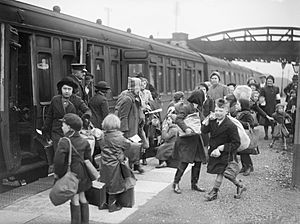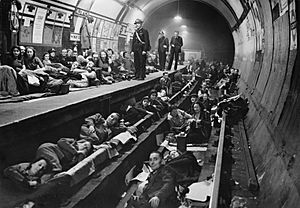Vidal Sassoon facts for kids
Quick facts for kids
Vidal Sassoon
|
|
|---|---|
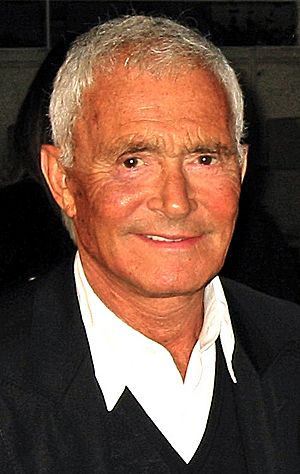
Sassoon in 2006
|
|
| Born | 17 January 1928 Hammersmith, London, England
|
| Died | 9 May 2012 (aged 84) Los Angeles, California, U.S.
|
| Citizenship |
|
| Occupation |
|
|
Notable work
|
Bob cut hairstyle |
| Spouse(s) |
Elaine Wood
(m. 1956; div. 1958)Beverly Adams
(m. 1967; div. 1981)Jeanette Hartford-Davis
(m. 1983, divorced)Rhonda "Ronnie" Holbrook
(m. 1992) |
| Children | 4, including Catya |
Vidal Sassoon (born January 17, 1928 – died May 9, 2012) was a famous British hairstylist, a smart businessman, and someone who loved helping others. He became well-known for bringing back a simple, short, and geometric haircut called the bob cut. Many famous people wore his styles, including fashion designer Mary Quant and actresses like Mia Farrow and Goldie Hawn.
Vidal had a very tough childhood. He grew up in extreme poverty and spent seven years living in an orphanage. He left school when he was 14 and took on different jobs in London during World War II. Even though he dreamed of becoming a professional football player, his mother suggested he become a hairdresser, and he followed her advice.
He quickly became known for his new and exciting haircuts. In the early 1970s, he moved to Los Angeles. There, he opened the first worldwide chain of hairstyling salons. He also created his own line of hair products.
In the early 1980s, Vidal sold his businesses. He used the money to support important research groups in Israel. A documentary film about his life, called Vidal Sassoon: The Movie, came out in 2010. In 2009, Queen Elizabeth II honored him at Buckingham Palace. In 2012, he was chosen as one of the important British cultural icons to appear on a new version of The Beatles' famous Sgt. Pepper's Lonely Hearts Club Band album cover.
Contents
Early Life and Challenges
Vidal Sassoon was born in Hammersmith, West London, to Jewish parents. His mother, Betty, was from the East End of London. Her family had moved to England from Ukraine in the 1880s to escape antisemitism and violence. His father, Jack Sassoon, was from Thessaloniki, Greece. They met in 1925 and got married in 1927. Vidal also had a younger brother named Ivor.
When Vidal was only three years old, his father left the family. His mother could no longer support them, and they lost their home. They had to move in with his mother's sister. Seven people lived in a tiny two-room apartment. It had no bathroom inside, and they had to share an outdoor toilet with three other families. Vidal remembered waiting in line for the toilet in very cold weather. The roof of their home was also broken, letting rain pour inside. Vidal described it as "ugliness all around."
Because of their poverty, Vidal's mother had to place him and his brother in a Jewish orphanage. They stayed there for seven years, until Vidal was 11, when his mother remarried. His mother was only allowed to visit them once a month and could not take them out.
School Days
Vidal went to Essendine Road Primary School, which was a Christian school. He was often teased by other students because he was Jewish. One of his proudest moments was winning the 100-yard dash race at school. He said, "The urge to win has never left me."
Vidal admitted he was "a very bad student" and got low grades in most subjects. However, he was good at mental arithmetic. He also volunteered as a choir boy at the local synagogue. This was one of the few chances he had to see his mother, who would come on Saturdays.
When World War II started on September 3, 1939, Vidal and other children were moved out of London for safety. He was eleven years old. He and his brother were taken to Holt, a small village.
First Jobs and a New Path
After returning to London, Vidal left school at 14. He worked as a messenger. London was still being bombed during the war, so he often had to sleep in underground shelters.
His mother really wanted him to become a hairdresser. Vidal, however, wanted to be a football player, which he was very good at. He said, "I could not imagine myself backcombing hair and winding up rollers for a living."
His mother took him to a famous hairdresser's school. They were told it was a two-year program and too expensive. His mother was very sad. But then, the owner, Adolph Cohen, called them back. He told Vidal, "You seem to have very good manners, young man. Start Monday and forget the cost." His mother cried with happiness.
Wartime Activities
When he was 17, Vidal was too young to fight in World War II. However, he joined the 43 Group. This was a secret Jewish group of veterans. They worked to stop fascist groups from spreading hateful messages in London after the war.
In 1948, at age 20, Vidal joined the Palmach. This group later became part of the Israel Defense Forces. He fought in the 1948 Arab–Israeli War, which started after Israel became a country. Vidal arrived in Mandatory Palestine in April 1948. He fought against the Egyptian Army in the Negev desert.
A Career in Hairdressing
Vidal Sassoon learned his skills from Raymond Bessone in London. In 1954, Vidal opened his first salon in London. His friend and neighbor, singer-actress Georgia Brown, was his very first customer.
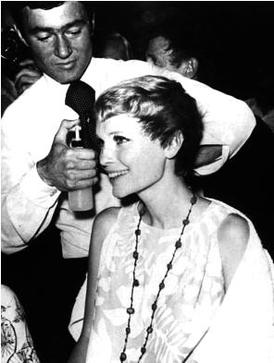
Vidal wanted to change hairdressing. He said, "If I was going to be in hairdressing, I wanted to change things. I wanted to eliminate the superfluous and get down to the basic angles of cut and shape." He created new, easy-to-care-for hairstyles. His styles, like the geometric perm and the "Nancy Kwan" cut, were modern and relied on the hair's natural shine.
In 1964, Sassoon brought back the classic "bob cut" with a new, short, and angular look. His geometric haircuts looked sharp but did not need hairspray. They used the hair's natural shine. An advertising executive named Natalie Donay helped bring Sassoon to the United States. In 1965, he opened his first New York City salon.
In 1966, he designed hairstyles for Emanuel Ungaro, inspired by 1920s film star Clara Bow. In 1968, director Roman Polanski brought Vidal to Hollywood. He paid $5,000 for Vidal to create a special pixie cut for Mia Farrow for her role in the movie Rosemary's Baby.
In the early 1970s, Vidal Sassoon moved to Los Angeles. In 1971, he made Roger Thompson, his second-in-command, the director of his salon. John Paul DeJoria, a friend of Sassoon, later started Paul Mitchell Systems with Paul Mitchell, who was one of Sassoon's former students. Mitchell called Sassoon "the most famous hairstylist in the history of the world."
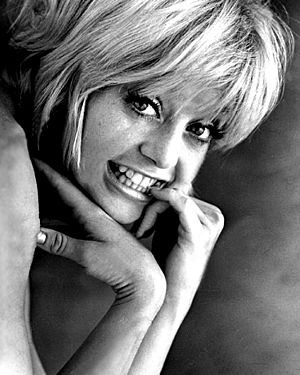
Vidal Sassoon started his own line of hair-care products in 1973. The actor Michael Caine said he inspired this idea. He told Vidal that he needed something that would make money even while he slept, like shampoos and other hair products. Whatever the reason, Sassoon's brand became famous worldwide. His commercials used the slogan "If you don't look good, we don't look good."
In the early 1980s, Vidal sold his business interests. He wanted to focus on helping others through charity work. By 2004, Vidal Sassoon was no longer directly involved with the brand that carried his name.
Honors and Personal Life
Vidal Sassoon was honored by Queen Elizabeth II at Buckingham Palace in 2009. He was made a Commander of the Order of the British Empire (CBE).
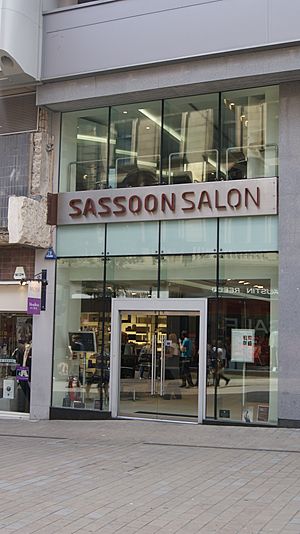
Vidal Sassoon was married four times. His first wife was Elaine Wood. In 1967, he married actress Beverly Adams. They had three biological children and adopted one son. Their daughter Catya became an actress. Vidal and Beverly later divorced. His third wife was Jeanette Hartford-Davis. In 1992, he married designer Rhonda "Ronnie" Sassoon.
Helping Others
Vidal Sassoon cared deeply about fighting antisemitism. In 1982, he started the Vidal Sassoon International Center for the Study of Antisemitism, or SICSA. This center, located at Hebrew University of Jerusalem, collects information about antisemitism around the world.
After selling his company, he focused on charity work through his Vidal Sassoon Foundation. He supported groups like the Boys Clubs of America and the Performing Arts Council of the Music Center of Los Angeles. He also helped with relief efforts after Hurricane Katrina. His foundation also provided money for education in Israel and other places. At the time of his death, he had hair academies in England, Canada, and the United States.
Illness and Passing
In June 2011, it was announced that Vidal Sassoon had been diagnosed with leukemia two years earlier. He passed away on May 9, 2012, at his home in Bel Air, Los Angeles. His family was with him when he died.
Legacy and Impact
Angus Mitchell, who studied under Sassoon, said, "Vidal was like Christopher Columbus. He discovered that the world was round with his cutting system. It was the first language that people could follow." Neil Cornelius, who now owns Sassoon's first salon, called him a "hairdressing legend."
Grace Coddington, a former model for Sassoon and a creative director at American Vogue, said that he changed how people thought about hair.
John Barrett of the John Barrett Salon said that Sassoon "was the creator of sensual hair." He added that Vidal changed the entire hairdressing industry, not just how hair was cut, but also by turning it into a big business. He was one of the first to have his product line bought by a major company.
Books and Films
- Sorry I Kept You Waiting, Madam (1968), his autobiography.
- A Year of Beauty and Health (1975), with Beverly Sassoon.
- Cutting Hair the Vidal Sassoon Way (1984).
- Vidal: The Autobiography (2010).
- Vidal Sassoon: The Movie (2010), a documentary film about his life.
See also
 In Spanish: Vidal Sassoon para niños
In Spanish: Vidal Sassoon para niños
- Vidal Sassoon International Center for the Study of Antisemitism


